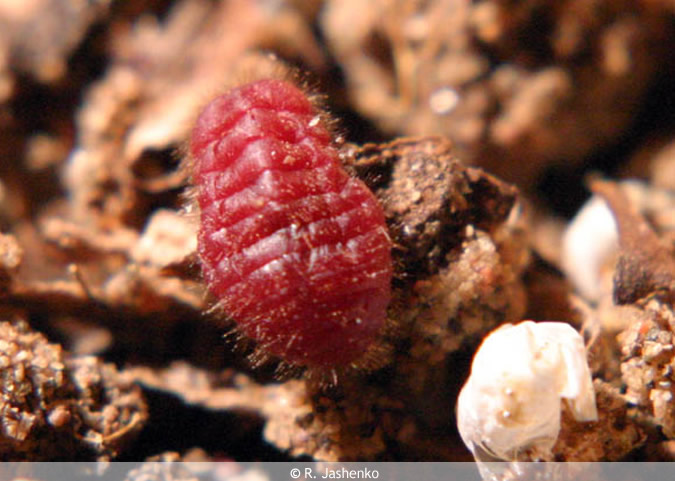Polish kermes lives in the roots of Scleranthus perennis L. Polish kermes are found from eastern Germany to the Ukraine . This shield louse, or scale insect, is a parasite on the roots of Scleranthus perennis. The female insects are collected in June, killed in a vinegar solution, dried, and marketed in this form as the raw material for the dyestuff. From a single plant, 40 to 50 insects can be collected. After they are taken from the roots of the host plant, it is replanted.Historical Data
The first written reference to Polish kermes - as "vermiculus " - is in an instruction from Charlemagne in 812 to the Carolingian estates. The use of red from Polish kermes in the Pazyryk Carpet proves, however, that this dye-insect was used much earlier, more than 2,500 years ago. Probably its qualities as a dyestuff were known and used even before then, a supposition that we cannot confirm, since the even earlier textile found in Takla Makan Desert , which have intense red and are now in the museum in Urumgi in China , have not yet been subject to a dye analysis. The Pazyrk carpet, the earliest pile carpet known, was named for the valley in the Altai Mountains of Siberia where it was found in the late 1940s.Another proof of the use of Polish kermes in dyeing was discovered recently, during the excavations of a cemetery from the end of the 6th century AD in Pfakofen, in Bavaria . In the tombs of a woman and a young girl, residue of Polish kermes was found besides tools for spinning. Although all dye animals (insect and purple snails) and dye plants existed in the Old World in the 12th century, Polish kermes was used mainly in the north and the center of Europe for red colour dyeing. For the dyers of the great textile areas of Western Europe, the Polish kermes has the advantage of being closer than Ararat Kermes and benefiting from trade-circuits well developed, thanks to the merchants of Hanse, who brought it in ship towards Holland and Flanders, and thanks to the Jewish, Armenian traders and Germans who collected it in Central Europe and forwards it by ground to Venice and Florence.The role of Constantinople was transportation of the Polish kermes to Eastern Mediterranean according to the Venetian merchant Giacomo Badoer s book of accounts, between 1436 and 1440.During this period, according to this contemporary Venetian book, price of one slave was equivalent to 107.38 g gold or 20.26 kg Ararat kermes. 1 kg of Ararat kermes allowed to dye 1.688 kg silk into crimson. The price of 10.957- 15.791 kg of polish kermes was equivalent to one slave ( 107.38 g gold) and 1 kg of Polish kermes allowed to dye 1.8- 2.6 kg of silk into crimson. For this reason, Polish kermes was cheaper than Ararat kermes.

